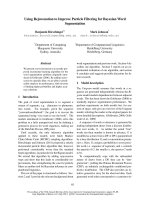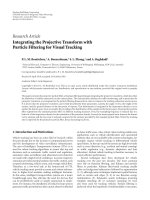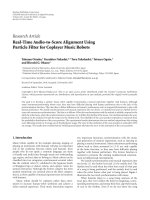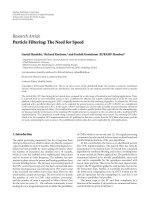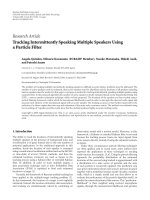Locally linearized particle filter
Bạn đang xem bản rút gọn của tài liệu. Xem và tải ngay bản đầy đủ của tài liệu tại đây (284 KB, 84 trang )
LOCALLY-LINEARIZED
PARTICLE FILTER
GAN LUHUI
(B.Sc), NTU
A THESIS SUBMITTED
FOR THE DEGREE OF MASTER OF
SCIENCE
DEPARTMENT OF STATISTICS AND APPLIED
PROBABILITY
NATIONAL UNIVERSITY OF SINGAPORE
2013
Declaration
I hereby declare that this thesis is my original work and it has been written by me in
its entirety. I have duly acknowdged all the source of information which have been
used in the thesis.
This thesis has also not been submitted for any degree in any university previously.
i
Contents
1
Introduction
1
1.1
Motivation . . . . . . . . . . . . . . . . . . . . . . . . . . . . . . .
1
1.2
Outline . . . . . . . . . . . . . . . . . . . . . . . . . . . . . . . .
3
2
Problem Statement
4
3
Extended Kalman Filter
8
3.1
8
Kalman filter . . . . . . . . . . . . . . . . . . . . . . . . . . . . .
3.1.1
3.2
4
Justification of Kalman filter . . . . . . . . . . . . . . . . . 10
Extended Kalman Filter . . . . . . . . . . . . . . . . . . . . . . . . 12
3.2.1
One-dimensional EKF . . . . . . . . . . . . . . . . . . . . 13
3.2.2
Derivation of Extended Kalman Filter . . . . . . . . . . . . 14
3.2.3
Multidimensional Extended Kalman Filter . . . . . . . . . . 20
Particle Filter
23
4.1
Basic Monte Carlo Method and Importance Sampling . . . . . . . . 24
4.2
Sequential Importance Sampling . . . . . . . . . . . . . . . . . . . 26
ii
4.3
Particle Filter . . . . . . . . . . . . . . . . . . . . . . . . . . . . . 28
4.4
Mixture Kalman Filter (Rao-Blackwellized PF) . . . . . . . . . . . 30
5
Locally-linearized Particle Filter I
32
6
Locally-linearized Particle Filter II
36
7
8
9
6.1
Motivation . . . . . . . . . . . . . . . . . . . . . . . . . . . . . . . 36
6.2
Algorithm . . . . . . . . . . . . . . . . . . . . . . . . . . . . . . . 37
6.3
Justification . . . . . . . . . . . . . . . . . . . . . . . . . . . . . . 39
6.4
Comment . . . . . . . . . . . . . . . . . . . . . . . . . . . . . . . 40
Numerical Example I
42
7.1
Settings . . . . . . . . . . . . . . . . . . . . . . . . . . . . . . . . 42
7.2
Results . . . . . . . . . . . . . . . . . . . . . . . . . . . . . . . . . 44
7.3
Remarks . . . . . . . . . . . . . . . . . . . . . . . . . . . . . . . . 46
Numerical Example II
48
8.1
Settings . . . . . . . . . . . . . . . . . . . . . . . . . . . . . . . . 48
8.2
Results . . . . . . . . . . . . . . . . . . . . . . . . . . . . . . . . . 49
8.3
Remarks . . . . . . . . . . . . . . . . . . . . . . . . . . . . . . . . 49
Discussion
53
A Justification of Multidimensional Extended Kalman Filter
57
B Proof of A.0.6 and A.0.7
65
iii
C R Code for Example 1
67
C.1 Initialize . . . . . . . . . . . . . . . . . . . . . . . . . . . . . . . . 67
C.2 Particle Filter . . . . . . . . . . . . . . . . . . . . . . . . . . . . . 67
C.3 Extended Kalman Filter . . . . . . . . . . . . . . . . . . . . . . . . 68
C.4 LLPF 1 . . . . . . . . . . . . . . . . . . . . . . . . . . . . . . . . 69
C.5 LLPF2 . . . . . . . . . . . . . . . . . . . . . . . . . . . . . . . . . 70
D R Code for Example 2
72
D.1 Initialize . . . . . . . . . . . . . . . . . . . . . . . . . . . . . . . . 72
D.2 Paticle Filter . . . . . . . . . . . . . . . . . . . . . . . . . . . . . . 72
D.3 Extended Kalman Filter . . . . . . . . . . . . . . . . . . . . . . . . 73
D.4 LLPF I . . . . . . . . . . . . . . . . . . . . . . . . . . . . . . . . . 74
D.5 LLPF II . . . . . . . . . . . . . . . . . . . . . . . . . . . . . . . . 75
iv
Summary
Nonlinear dynamic systems with Gaussian noise are widely used in applied fields.
Extended Kalman filter (EKF) and particle filter (PF) are two traditional methods
in estimating these systems. In the thesis, two algorithms called locally-linearized
particle filters are proposed. Both of them combine the idea of EKF and PF. In
the first algorithm, process noises are split into two parts. One part is realized in
random samples, leaving out a remaining system on which EKF is applied. In the
second algorithm, same procedure is conducted, but results from EKF are not the
final estimates. Instead, they are used to construct a sampling scheme that generate
samples from the target distribution. Results from simulation studies show that both
methods gain improvements over EKF and PF.
v
List of Tables
7.1
Errors of Numerical Example I . . . . . . . . . . . . . . . . . . . . 46
8.1
Errors of Numerical Example II . . . . . . . . . . . . . . . . . . . 52
vi
List of Figures
7.2.1 Posterior Density Estimation . . . . . . . . . . . . . . . . . . . . . 44
7.2.2 Effective sample sizes for each filter with 1,000 particles and resampling threshould 300 . . . . . . . . . . . . . . . . . . . . . . . 45
8.2.1 Posterior Density Estimation . . . . . . . . . . . . . . . . . . . . . 50
8.2.2 ESS for Example II . . . . . . . . . . . . . . . . . . . . . . . . . . 51
vii
Chapter 1
Introduction
1.1
Motivation
Dynamic systems are widely used in applied fields such as signal processing, computer vision and finance. Today, many real-world data analysis tasks involve estimating dynamic systems from some inaccurate observations generated by the system. In most cases, some prior information about the underlying dynamic system is
available. These problems are often formulated as Bayesian models, which consist
of a prior distribution about the unobserved model parameters and a likelihood that
links these unknown parameters with observations. Under Bayesian framework,
inference about the underlying system is based on the posterior distribution, which
can be obtained using Bayes’ theorem. Moreover, observations often come in a
sequential manner and one would like to make inference on-line, i.e., update the
posterior distribution whenever a new observation is available.
1
When the underlying dynamic system is a linear one with Gaussian error, there is
an analytic expression for the posterior distribution. An algorithm to compute this
distribution was provided by Kalman (1960). However, for non-linear Gaussian
state-space model, there is no universal effective approach to on-line estimation.
Several methods have been proposed to surmount these problems. The effectiveness
of them depends on the nature of individual problems. These methods can be classified into two main streams. The first stream focus on approximating the system
with locally linear (sometimes higher order) functions and derive an analytic solution. Some well known algorithms are extended Kalman filter (Gelb, 1974), Gaussian sum filters (Anderson and Moore, 1979) and iterated extended Kalman filter
(Jazwinski, 1970). The second stream of methods attempt to draw representative
samples directly from the posterior distributions and use these samples for inference. It began with the seminal paper introducing sequential Monte Carlo method
(also called particle filter) for filtering (Gordon, Salmond and Smith, 1993). Since
its origin, modifications and improvements have been suggested, including mixture
Kalman filter (Liu and Chen, 2000) and Rao-Blackwellization (Doucet, Godsill and
Andrieu, 2000).
In the thesis, two algorithms are proposed. We call them locally-linearized particle
filters (LLPF I and LLPF II). The motivation of them is splitting the process noise
into two parts, realizing part of system in a random sample and using approximation
algorithms to estimate the remaining part. In the first algorithm, approximation is
conducted using extended Kalman filter while in the second algorithm, results from
extended Kalman filter are not directly used as estimates. Rather, they are used to
2
construct a sampling scheme to generate samples from the posterior distribution.
To evaluate the performance of the two methods, we conduct simulation studies.
1.2
Outline
The thesis consist of 8 chapters. Chapter 2 describes the general framework on
which we formulate our inference problem. Based on the framework, we then introduce two classical methods to tackle the inference problem. In Chapter 3, we
review Kalman filter and its generalization, extended Kalman filter. In addition, we
derive extended Kalman filter based on second order approximation (the standard
approach uses linear approximation only). In Chapter 4, we give review on particle
filter. We build up the algorithm step by step, starting from the simplest Monte
Carlo method. The next two chapters are devoted to the development of two new
methods, locally-linearized particle filters. In Chapter 5, we introduce our first algorithm, LLPF I and in Chapter 6, we introduce a modified particle filter which we
call LLPF II. Two simulation studies have been done and the results are summarized
in Chapter 7 and Chapter 8 respectively.
3
Chapter 2
Problem Statement
We restrict ourselves to non-linear Markovian state-space models with Gaussian
noises. We assume that the unobserved(hidden) state {xt ;t ∈ N}, xt ∈ Rk1 is a
Markov process with initial distribution p(x0 ) and transition equation xt = f (xt−1 )+
wt , where f : Rk1 → Rk1 is a smooth function and wt is the process noise having independent k1 -dimensional Gaussian distribution with mean 0 and covariance matrix
W . At each time t, an observation yt ∈ Rk2 is made according to yt = g(xt ) + vt ,
where g : Rk1 → Rk2 is smooth function and vt is assumed to be k2 -dimensional
Gaussian white noise with zero mean and covariance matrix V . For sake of simplicity, the dependence of structure of xt on xt−1 and yt on xt are assumed to be
time-independent. All algorithms described in the thesis can be easily generalized
to cases where the dependence structure are time-dependent.
To sum up, the model can be described as:
4
xt
=
f (xt−1 ) + wt ,
(2.0.1)
yt
=
g(xt ) + vt ,
(2.0.2)
wt ∼iid N(0,W ),
(2.0.3)
vt ∼iid N(0,V ).
(2.0.4)
for t ≥ 1, where xt are k1 -dimensional vectors that represent the unobserved state of
the system; yt are k2 -dimensional observations. The process noise wt is a vector of
dimension k1 , having multivariate Gaussian distribution with covariance matrix R;
the observation noise vt is a vector of dimension k2 , having multivariate Gaussian
distribution with covariance matrix S. Note that the conditional density functions
p(xt |xt−1 ) and p(yt |xt ) can be written out explicitly.
1
1
p(xt |xt−1 ) = |(2π)k1 W |− 2 exp{− (xt − f (xt−1 ))T W −1 (xt − f (xt−1 ))},
2
1
1
p(yt |xt ) = |(2π)k2 V |− 2 exp{− (yt − g(xt ))T V −1 (yt − f (xt ))}.
2
We denote [x0 , x1 , ..., xt ] as x0:t and [y, y2 , ..., yt ] as y1:t .
Our main task is to infer about the posterior distribution p(x0:t |y1:t ) and its marginal
distribution p(xt |y1:t ). In particular, the following integration is often of our interest:
ˆ
h(x0:t )p(x0:t |y1:t )dx0:t
5
for some function h. Using Bayes theorem, the posterior distribution can be expressed as
p(x0:t |y1:t ) = ´
p(y1:t |x0:t )p(x0:t )
p(y1:t |x0:t )p(x0:t )dx0:t
∝ p(y1:t |x0:t )p(x0:t ).
By our model assumption, each xt only depends on its predecessor and each yt only
depends on xt . Therefore the posterior distribution can be factored as
t
p(x0:t |y1:t ) ∝ p(x0 ) ∏ p(xi |xi−1 )p(yi |xi ).
i=1
The above expression looks simple, but making inference from it is a difficult task.
Moreover, we desire our estimates to be on-line. That is to say, when a new observation yt+1 comes in, we do not have to re-estimate. Instead, we only have to alter
our previous estimates to obtain new ones. For this reason, Markov Chain Monte
Carlo method is not suitable for these problems because it will have to sample from
the joint distribution p(x0:t |y1:t ) at every time t. Information from previous runs is
not fully utilized.
In the next chapter, we will introduce the extended Kalman filter which approximate
the above distribution with one that is easier to handle. In Chapter 4, we introduce
particle filter that approximate this distribution by drawing representative sample
from it.
The following is an real example of such system.
6
Example 1. Bearings-only Target Tracking
Consider a target that moving on the x − y plane according to the following model
xt = Φxt−1 + Γwt ,
where xt is a vector of length 4, wt is a Gaussian white noise with mean 0 and
variance
1,
1 1 0
0 1 0
Φ=
0 0 1
0 0 0
0
0
and Γ =
1
1
0.5
1
0
0
0
0
.
0.5
1
The first and the third entries of xt denote the coordinate of the target in a plane,
while the second and the fourth entries denote its velocity along the plane. Thus
all information about the position and velocity of the target at time t is contained
in xt . At each time t, there is a fixed sensor (observer) at origin who takes a noisy
measurement on target bearing:
yt = acrtan(
where vt ∼ N(0, 0.0052 ).
7
xt [3]
) + vt ,
xt [1]
Chapter 3
Extended Kalman Filter
This chapter aims at introducing extended Kalman filter and deriving its algorithm
based on second-order approximation. For illustration purpose, we first introduce
Kalman filter and show why it is optimal for linear systems with Gaussian noise.
The derivation of extended Kalman filter is thus straight forward, except that at
certain points we need to take approximations. This is done in Section 3.4 onwards.
3.1
Kalman filter
Consider the dynamic system described by 2.0.1 to 2.0.4. When both f and g are
linear functions, the system can be re-written as:
xt = F × xt−1 + G + wt
8
(3.1.1)
yt = H × xt + J + vt
(3.1.2)
wt ∼ iid N(0,W )
(3.1.3)
vt ∼ iid N(0,V )
(3.1.4)
where F is a matrix of dimension k1 times k1 , G is a vector of length k1 , H is a
matrix of dimension k2 times k1 , J is a vector of length k2 , “×” denotes matrix
multiplication.
If the initial state x0 follows a Gaussian distribution, it is ready to see that the joint
distribution of yt and xt is Gaussian. Furthermore, the conditional distribution of
p(xt |yt ) is Gaussian and can be represented by a mean vector xˆt|t and a covariance
matrix Pˆt|t .
Kalman filter gives out an explicit procedure to calculate these two quantities. Its
algorithm can be summarized as the followings:
1. Initializing: choose initial estimates xˆ0|0 and Pˆ0|0 ; set t = 1
2. Prediction:
(a) Predict state estimate: xˆt|t−1 = F × xˆt−1|t−1 + G
(b) Predict estimate covariance: Pˆt|t−1 = F × Pˆt−1|t−1 × F T +W
3. Updating:
(a) Innovation: y˜t = yt − H × xˆt|t−1
(b) Innovation covariance: Qt = H × Pˆt|t−1 × H T +V
9
(c) Optimal Kalman gain: Kt = Pˆt|t−1 × H T × Qt−1
(d) Updated state estimate: xˆt|t = xˆt|t−1 + Kt × y˜t
(e) Updated estimate covariance: Pˆt|t = (I − Kt × Ht )Pˆt|t−1
3.1.1
Justification of Kalman filter
To show the optimality of Kalman filter, it suffices to show that the distribution
p(xt |y1:t ) is Gaussian with mean xˆt|t and variance Pˆt|t . We shall prove this by induction.
By induction assumption, we have: xt−1 |y1:t−1 ∼ N(xˆt−1|t−1 , Pˆt−1|t−1 ).
Prediction step
From 3.1.1, it is easy to see that xt |y1:t−1 is normally distributed
with mean and variance given by:
E[xt |y1:t−1 ] = E[Fxt−1 + G|y1:t−1 ] + E[wt ]
= FE[xt−1 |y1:t−1 ] + G
= F xˆt−1|t−1 + G
and
Var[xt |y1:t−1 ] = Var[Fxt−1 + G|y1:t−1 ] +Var[wt ]
= FVar[xt−1 |y1:t−1 ]F T +W
= F Pˆt−1|t−1 F T +W
10
Comparing with the Kalman filter algorithm, we see that xˆt|t−1 and Pˆt|t−1 are exactly
the conditional expectation and conditional variance of xt |y1:t−1 .
The next step is to compute the posterior distribution of xt |y1:t .
Updating step Observe that yt |xt is normally distributed with mean Hxt + J and
variance V . Hence conditioning on y1:t−1 , (xt , yt ) has a joint normal distribution
with mean and variance given by:
xt
E[xt |y1:t−1 ]
y1:t−1 =
E
yt
HE[xt |y1:t−1 ] + J
xˆ
t|t−1
=
H xˆt|t−1 + J
and
xt
Var[xt |y1:t−1 ]
Cov(xt , yt |y1:t−1 )
Var y1:t−1 =
Cov(xt , yt |y1:t−1 )T Var[Ht xt + Jt |y1:t−1 ] + St
yt
Pˆ
Pˆt|t−1 H T
t|t−1
=
H Pˆt|t−1 H Pˆt|t−1 H T +V
11
Using the formula for conditional distribution of normal random vector, we see that
xt |y1:t has a normal distribution with mean and variance given by:
E[xt |y1:t ] = E[xt |y1:t−1 ] +Cov(xt , yt |y1:t−1 )Var(yt |y1:t−1 )−1 (yt − E[yt |y1:t−1 ])
= xˆt|t−1 + Pˆt|t−1 H T (H Pˆt|t−1 H T +V )−1 (yt − H xˆt|t−1 + J)
Var[xt |y1:t ] = Var[xt |y1:t−1 ] −Cov(xt , yt |y1:t−1 )Var(yt |y1:t−1 )−1Cov(xt , yt |y1:t−1 )T
= Pˆt|t−1 − Pˆt|t−1 H T (H Pˆt|t−1 H T +V )−1 H Pˆt|t−1
Comparing with the Kalman filter algorithm, we see that in the algorithm xˆt|t and
Pˆt|t are exactly the posterior mean and variance of xt |y1:t . Since p(xt |y1:t ) has a
normal distribution, we have shown that Kalman filter gives exact estimates of the
posterior distribution, under the assumption of linear system and Gaussian noises.
3.2
Extended Kalman Filter
Kalman filter requires the dynamic system, described in 2.0.1 to 2.0.4, to be linear.
However, there are often more complex systems that are highly non-linear, in which
case Kalman filters are not directly applicable. Extended Kalman filter is an generalization of Kalman filter that can be applied to these problems. It is an algorithm
based on linear (or higher-order) approximations of the system. In this section, we
12
derive the extended Kalman filter based on second-order approximation.
For sake of simplicity, we first demonstrate and derive the one-dimensional extended Kalman filter. This is a special case where xt and yt are both scalars. We
then generalize our algorithms to higher dimensional spaces later.
3.2.1
One-dimensional EKF
Consider the model described in Chapter 2, assume that xt and yt are of dimension 1
(k = 1). The one-dimensional extended Kalman filter can be implemented through
the following steps:
1. Initializing: choose initial estimates xˆ0|0 and Pˆ0|0 ; set t = 1
2. Prediction:
(a) Predict state estimate: xˆt|t−1 = f (xˆt−1|t−1 ) + 12 f (xˆt−1|t−1 )Pˆt−1|t−1
(b) Predict estimate covariance:
Pˆt|t−1 = [ f (xˆt−1|t−1 )]2 Pˆt−1|t−1 + 12 [ f (xˆt−1|t−1 )]2 [Pˆt−1|t−1 ]2 +W
3. Updating:
(a) Innovation: y˜t = yt − g(xˆt|t−1 ) − 12 g (xˆt|t−1 )Pˆt|t−1
(b) Innovation covariance:
Qˆ t = [g (xˆt|t−1 )]2 Pˆt|t−1 + 12 [ f (xˆt−1|t−1 )]2 [Pˆt|t−1 ]2 +V
(c) Optimal Kalman gain: Kt = Pˆt|t−1 × g (xˆt|t−1 ) × Qˆ t−1
13
(d) Updated state estimate: xˆt|t = xˆt|t−1 + Kt × y˜t
(e) Updated estimate covariance: Pˆt|t = (1 − Kt × g (xˆt|t−1 ))Pˆt|t−1
where f and f denote the first and second derivative of f
3.2.2
Derivation of Extended Kalman Filter
In this subsection, we derive the one-dimensional extended Kalman filter based
on second-order approximations.The derivation is similar to that of Kalman filter.
We make two crucial assumptions. First, the posterior distribution p(xt |y1:t−1 ) can
be approximated by a normal distribution. The second assumption is that the joint
distribution p(xt , yt ) can be approximated by a multivariate normal distribution. For
both distributions, we use Taylor expansion to estimate their means and variances.
Prediction Step
Suppose at time t − 1, we have obtained an estimate of xt−1 and
its covariance matrix, denoted as xˆt−1|t−1 and Pˆt−1|t−1 . Assume that xt−1 |y1:t−1 ∼
N(xˆt−1|t−1 , Pˆt−1|t−1 ), we would like to estimate p(xt |y1:t−1 ). By our assumption,
this is a normal distribution. To estimate its mean and variance, we consider the
Taylor expansion of f (xt−1 ) around xˆt−1|t−1 :
f (xt−1 ) = f (xˆt−1|t−1 ) + f (xˆt−1|t−1 )(xt−1 − xˆt−1|t−1 ) +
1
f (xˆt−1|t−1 )(xt−1 − xˆt−1|t−1 )2 + O(|xt−1 − xˆt−1|t−1 |3 ).
2
14
Substitute into 2.0.1, we obtain:
1
xt = f (xˆt−1|t−1 ) + f (xˆt−1|t−1 )(xt−1 − xˆt−1|t−1 ) + f (xˆt−1|t−1 )(xt−1 − xˆt−1|t−1 )2
2
+O(|xt−1 − xˆt−1|t−1 |3 ) + wt .
(3.2.1)
Taking expectation on both sides yields:
1
E[xt |y1:t−1 ] = f (xˆt−1|t−1 ) + 0 + f (xˆt−1|t−1 )Var(xt−1 ) + O(|xt−1 − xˆt−1|t−1 |3 )
2
1
= f (xˆt−1|t−1 ) + f (xˆt−1|t−1 )Pˆt−1|t−1 + O(|xt−1 − xˆt−1|t−1 |3 ),
2
here we are using the assumption that xt−1 |y1:t−1 ∼ N(xˆt−1|t−1 , Pˆt−1|t−1 )
Ignoring the error term, we have:
1
xˆt|t−1 = f (xˆt−1|t−1 ) + f (xˆt−1|t−1 )Pˆt−1|t−1
2
(3.2.2)
To estimate the variance of p(xt |y1:t−1 ) we compute the variance of RHS of 3.2.1:
15
Var(xt |y1:t−1 ) = [ f (xˆt−1|t−1 )]2Var[(xt−1 − xˆt−1|t−1 )]
1
+ [ f (xˆt−1|t−1 )]2Var[(xt−1 − xˆt−1|t−1 )2 ]
4
+ f (xˆt−1|t−1 ) f (xˆt−1|t−1 )Cov[(xt−1 − xˆt−1|t−1 ), (xt−1 − xˆt−1|t−1 )2 ]
+Var(wt ) + O(|xt−1 − xˆt−1|t−1 |4 )
1
= [ f (xˆt−1|t−1 )]2 Pˆt−1|t−1 + [ f (xˆt−1|t−1 )]2Var[(xt−1 − xˆt−1|t−1 )2 ]
4
+ f (xˆt−1|t−1 ) f (xˆt−1|t−1 )Cov[(xt−1 − xˆt−1|t−1 ), (xt−1 − xˆt−1|t−1 )2 ]
+W + O(|xt−1 − xˆt−1|t−1 |4 ).
(3.2.3)
To compute the second term in 3.2.3, note that xt−1 |y1:t−1 ∼ N(xˆt−1|t−1 , Pˆt−1|t−1 )
implies that (xt−1 − xˆt−1|t−1 )2 /Pˆt−1|t−1 has a Chi-square distribution with degree of
freedom 1, which has variance 2. Hence:
Var[(xt−1 − xˆt−1|t−1 )2 ] = 2[Pˆt−1|t−1 ]2
(3.2.4)
The covariance term (third term in 3.2.3) is 0 since:
Cov[(xt−1 − xˆt−1|t−1 ), (xt−1 − xˆt−1|t−1 )2 ] = E[(xt−1 − xˆt−1|t−1 )3 ] = 0.
Ignoring higher order terms, we obtain an estimate of the variance of xt |y1:t−1 :
1
Pˆt|t−1 = [ f (xˆt−1|t−1 )]2 Pˆt−1|t−1 + [ f (xˆt−1|t−1 )]2 [Pˆt−1|t−1 ]2 +W.
2
16
(3.2.5)
Comparing 3.2.5 with the extended Kalman filter algorithm, we see that xˆt|t−1
and Pˆt|t−1 in the algorithm are estimates of the posterior mean and variance of
p(xt |y1:t−1 ) respectively.
Updating Step Suppose now a new observation yt is available, we would like to
update the estimate of xt based on y1:t
We know that xt |y1:t−1 ∼ N(xˆt|t−1 , Pˆt|t−1 ), where xˆt|t−1 and Pˆt|t−1 are given in 3.2.2
and 3.2.4 respectively. Here we make a crucial assumption that (xt , yt )|y1:t−1 has a
jointly normal distribution:
xt
y1:t−1 ∼ N
yt
E[xt |y1:t−1 ]
,
E[yt |y1:t−1 ]
Var(xt |y1:t−1 ) Cov(xt , yt |y1:t−1 )
.
Cov(yt , xt |y1:t−1 ) Var(yt |y1:t−1 )
To obtainp(xt |y1:t ), we estimate the mean and variance of in the above expression
and use the formula for conditional distribution in normal random vectors. We already have the estimate of E[xt |y1:t−1 ] and Var[xt |y1:t−1 ], which are xˆt|t−1 and Pˆt|t−1
respectively. Our estimates of the remaining terms are based on Taylor expansion
of g(xt ).
Consider the following Taylor expansion of g(xt ) around xˆt|t−1 :
1
g(xt ) = g(xˆt|t−1 )+g (xˆt|t−1 )(xt − xˆt|t−1 )+ g (xˆt|t−1 )(xt − xˆt|t−1 )2 +O(|xt−1 − xˆt−1|t−1 |3 ).
2
Substitute into 2.0.2, we have:
17



